Muscle Insider
New member
If you’re hitting the gym on International Chest Day, you need the best chest exercises for mass, strength, and everything in-between. These 17 expert-selected movements are all but guaranteed to get you jacked, increase your strength, and help you stave off injury. Let’s get started. 17 Best Chest Exercises Recent Updates: This article was initially written by Mike...
The post The Best Chest Exercises for Building Muscle, Plus 4 Full Workouts appeared first on BarBend.
If you’re hitting the gym on International Chest Day, you need the best chest exercises for mass, strength, and everything in-between. These 17 expert-selected movements are all but guaranteed to get you jacked, increase your strength, and help you stave off injury. Let’s get started.
17 Best Chest Exercises
[*]Flat Bench Press
[*]Incline Bench Press
[*]Decline Bench Press
[*]Dip
[*]Dumbbell Bench Press
[*]Dumbbell Floor Press
[*]Incline Dumbbell Hex Press
[*]Chest Flye
[*]Cable Press-Around
[*]Decline Push-Up
[*]Close-Grip Bench Press
[*]Svend Press
[*]Push-Up
[*]Cable Crossover
[*]Plyo Push-Up
[*]Dumbbell Pullover
[*]Close-Grip Push-Up
Recent Updates: This article was initially written by Mike Dewar, CSCS. It was edited by Alex Polish, Senior Editor and a certified personal trainer. On Mar. 4, 2024, BarBend‘s exercise selections were adjusted by BarBend Senior Writer Jake Dickson in order to better reflect science-based guidance for movement recommendations. Dickson holds a B.S. degree in Exercise Science and is a NASM-certified personal trainer.
1. Flat Bench Press
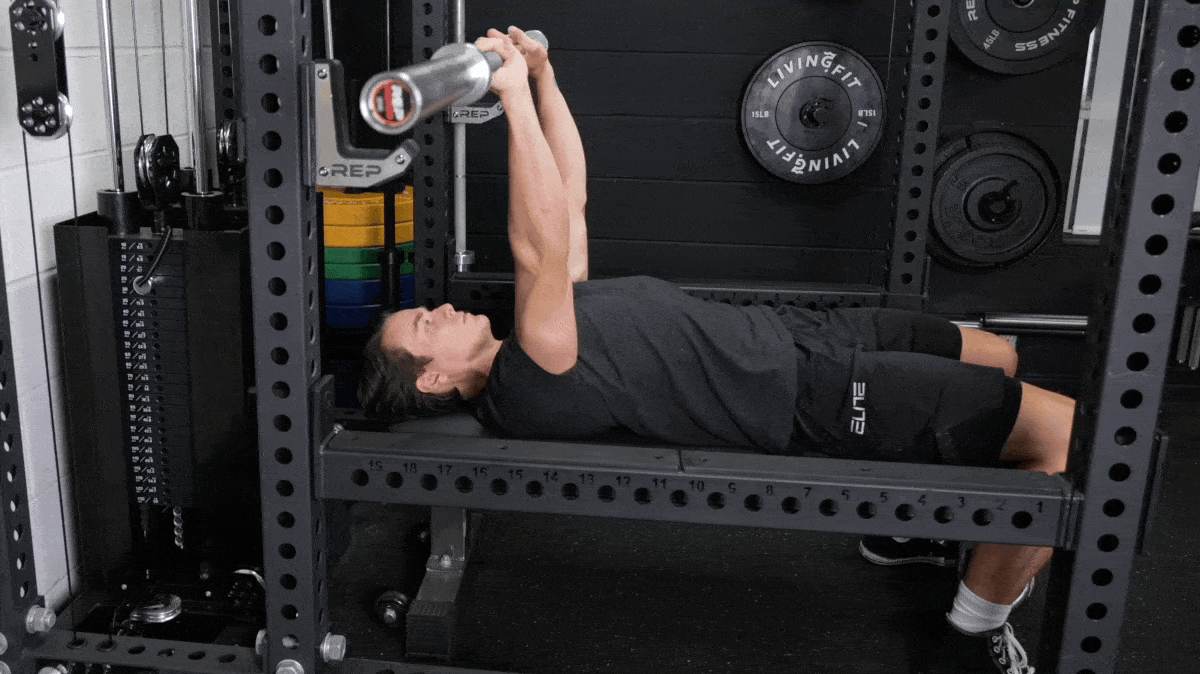
The bench press should be a staple in your routine for more chest size and strength, since compared to most other chest exercises, you can load the bench press up with a relatively heavy amount of weight. Beyond that, benching is necessary for powerlifters, since it’s one of the three lifts judged in a powerlifting meet.
How To Do It
[*]Lay back down on a bench, arch your lower back slightly, and plant your feet on the floor.
[*]Pull your shoulder blades together to enhance stability and upper back strength.
[*]Grab the bar and squeeze the hand hard to flex the arm and grip muscles maximally.
[*]With the load unracked, think about pulling the barbell to the body to touch the sternum/base of the chest.
[*]Press the weight upwards, making sure to keep your back tight, and shoulder blades pulled together.
Modifications
Coach’s Tip: A strong spinal arch will reduce your range of motion and improve your leverage.
2. Incline Bench Press
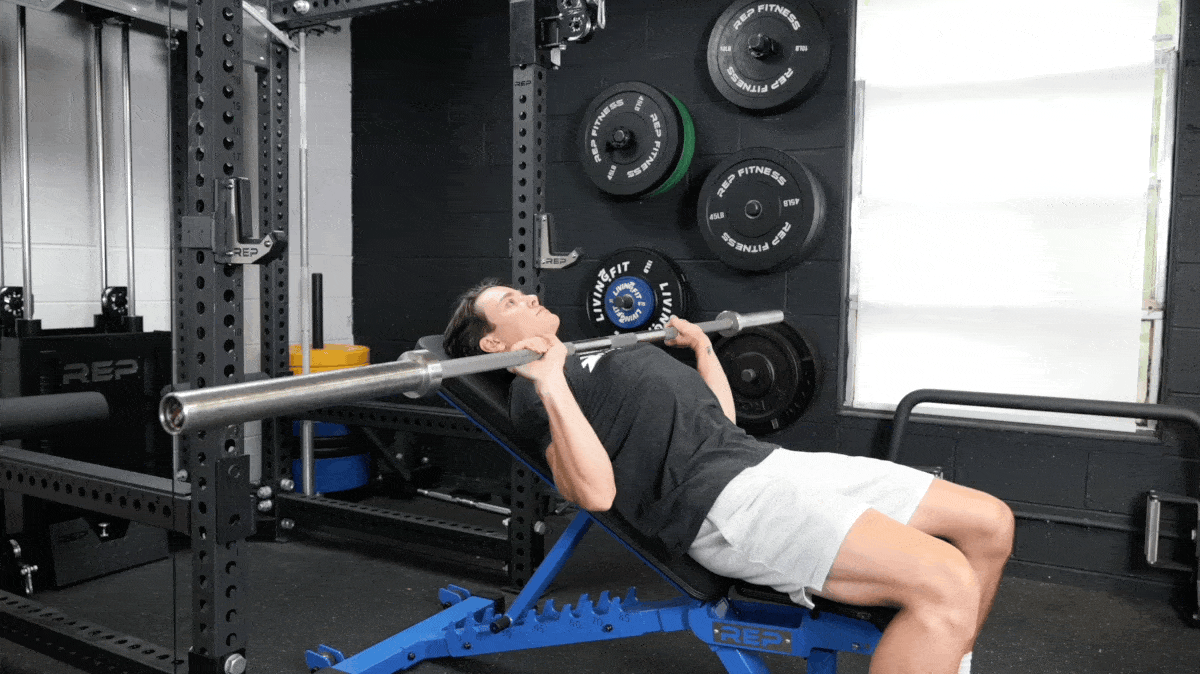
The incline press is somewhat of a hybrid of an overhead press and flat bench press, and so pressing a barbell (or a pair of kettlebells or dumbbells) from an incline recruits more of the muscle fibers in the upper chest and taxes the shoulders a bit more.
How To Do It
[*]Adjust a weight bench so it is at a 45-degree angle and set up similarly to that of the flat bench press.
[*]Unrack the loaded barbell and begin to pull the load downwards to line with the upper chest (a few inches below the clavicle).
[*]With the shoulder blades pulled together and elbows angled at about 45 degrees.
[*]Push the barbell upward.
Modifications
Coach’s Tip: Adjust the seat such that the barbell is slightly behind your eye line before you unrack it.
3. Decline Bench Press
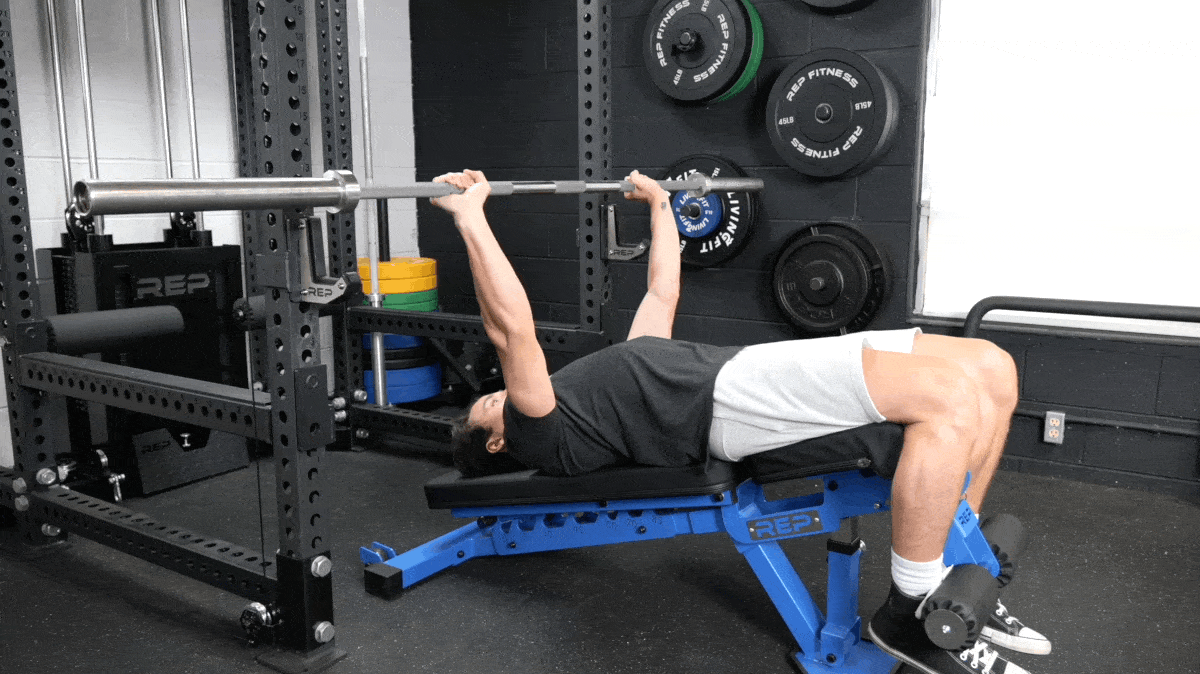
[Read More: 5 Bench Press Programs to Build a Bigger, Stronger Chest]
This pressing variation is typically less strenuous on your shoulders than the standard bench press because of the shifted shoulder angle. You’ll also be able to target your inner chest from a different angle, which is important when you’re looking to develop a well-rounded musculature.
How To Do It
[*]Start by securing your feet into a decline bench set up and secure your upper back and hips to the bench (similar to the flat bench press).
[*]Unrack the weight and pull the load downwards toward the sternum while keeping the shoulder blades pulled together.
[*]Press through the barbell to lock out your elbows. Be sure not to allow the elbows to flare excessively out.
Modifications
Coach’s Tip: The barbell should hit lower on your chest than during a flat bench press or incline bench press.
4. Dip
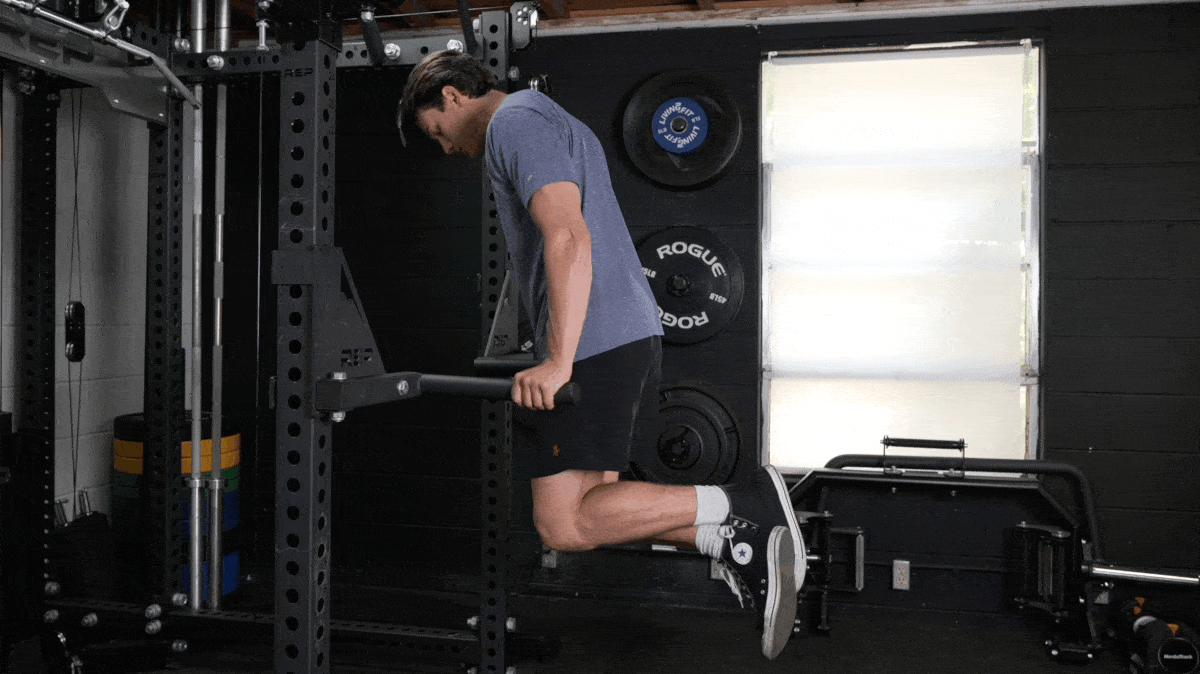
The dip is another bodyweight gem. It comes out toward the top of this list and is also one of the best arm exercises out there — the dip really is a powerhouse. You’ll also seriously recruit your triceps, which are essentially involved in all pressing movements, so working them in tandem with the chest will help strengthen the synergistic muscles in unison.
How To Do It
[*]Grab the dip bar firmly and get yourself in the top of the dip position, with your upper back tight and shoulder blades squeezed together.
[*]Angle your torso slightly forward and allow your elbows to bend as they slightly tuck inwards towards the sides of the torso.
[*]Lower yourself down until your elbows bend at about 90 degrees.
[*]When ready, press through the handles and bring your body upright into the top of the dip position.
Modifications
Coach’s Tip: Keep your shoulders packed down and away from your ears the entire time.
5. Dumbbell Bench Press
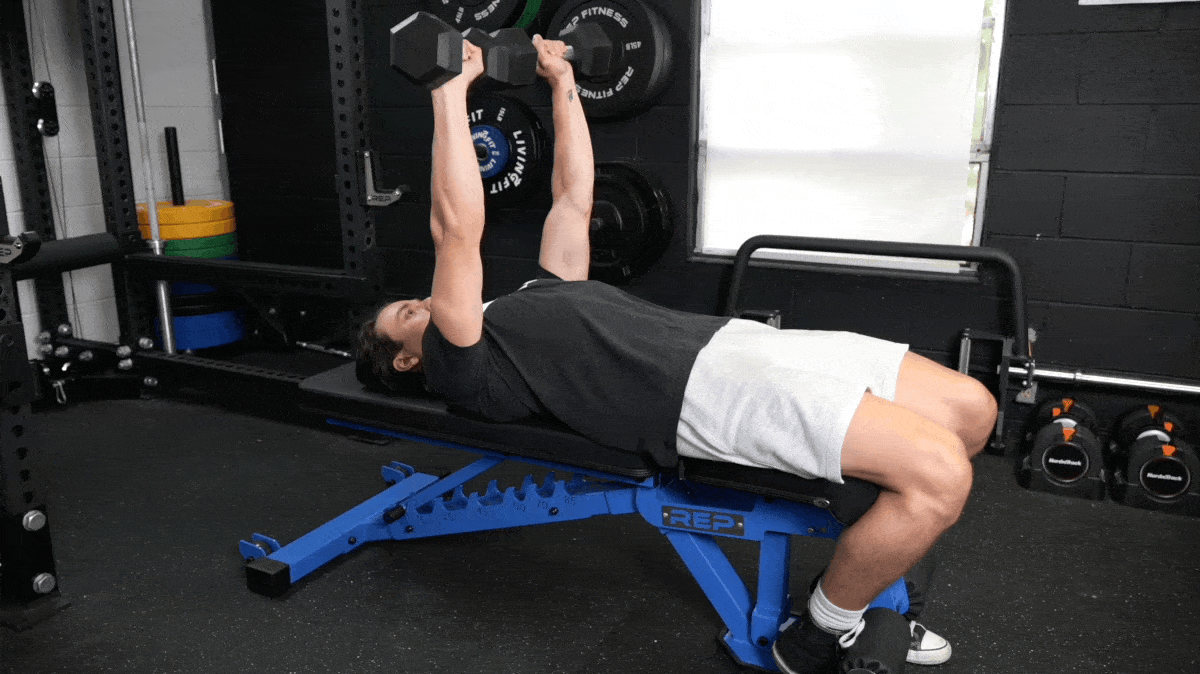
The dumbbell bench press doesn’t allow you to go as heavy as its barbell counterpart, but there’s a lot to like about this move. For one, you’re controlling two dumbbells, which works your chest (and the smaller stabilizer muscles around your shoulder joint) differently than the bench press.
Like all chest exercises with dumbbells, this move has a secret weapon — if you have a weaker side, this move’s unilateral nature allows one side to catch up to the other.
How To Do It
[*]Sit up on a flat bench and then hinge forward to pick up each dumbbell.
[*]Place each weight on a knee and get set.
[*]Lean back and then drive the dumbbells back towards you (carefully) with your knees, simultaneously pressing the weights over your chest.
[*]Lower the weights, keeping your elbows tucked in at 45 degrees until your elbows break 90 degrees.
[*]Then, drive the dumbbells back up.
Modifications
Coach’s Tip: Push the weights both upward and in toward your midline.
6. Cable Press
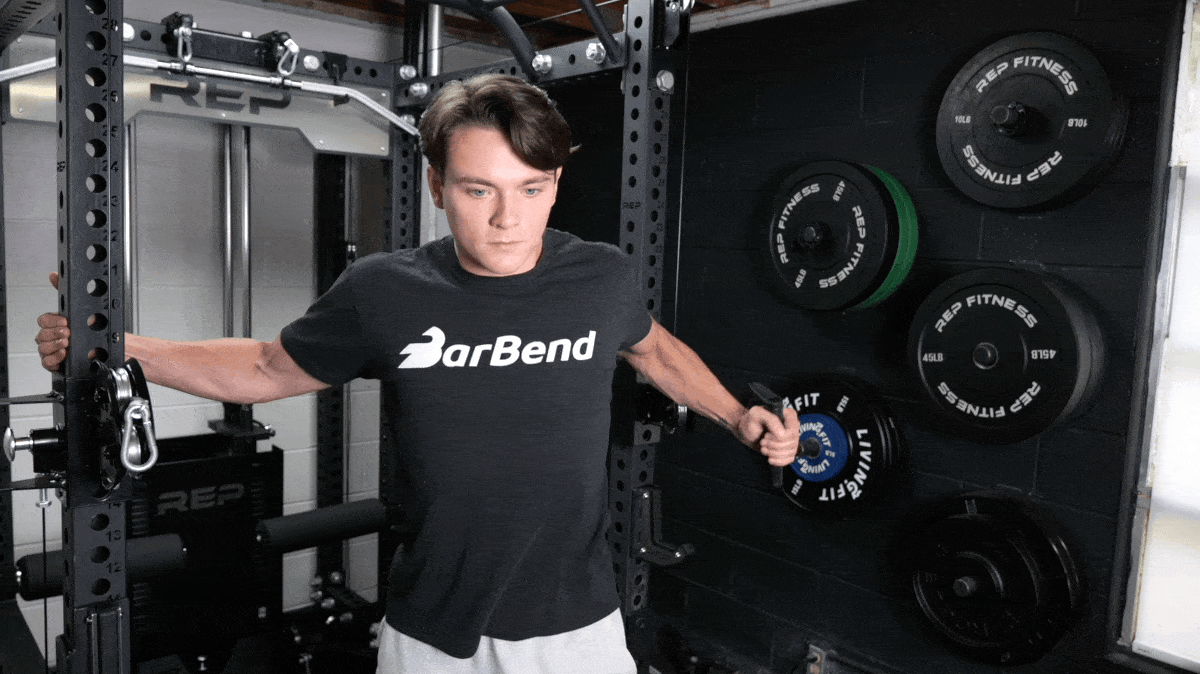
The cable press allows you to to train your pecs through their two primary anatomical functions; arm adduction and shoulder flexion. In simple terms, the tension of the cable pulls your arm both backward and out to the side, doubling down on the stimulus to your pecs.
How To Do It
[*]Set up an adjustable weight bench a few feet in front of a cable station with the seat elevated high.
[*]The cables should be fixed with D-handle attachments and set to around shoulder height when you sit on the bench.
[*]Stand behind the bench, grab each handle, and step around the bench to sit in it.
[*]Simulate a chest press position while holding the handles with your elbows bent and out to the sides.
[*]Perform a chest press, driving the handles forward and inward toward your midline.
Modifications
Coach’s Tip: The setup for the cable press is clunky, especially if you use heavy weights. You may want a spotter’s help getting into position.
7. Incline Dumbbell Hex Press
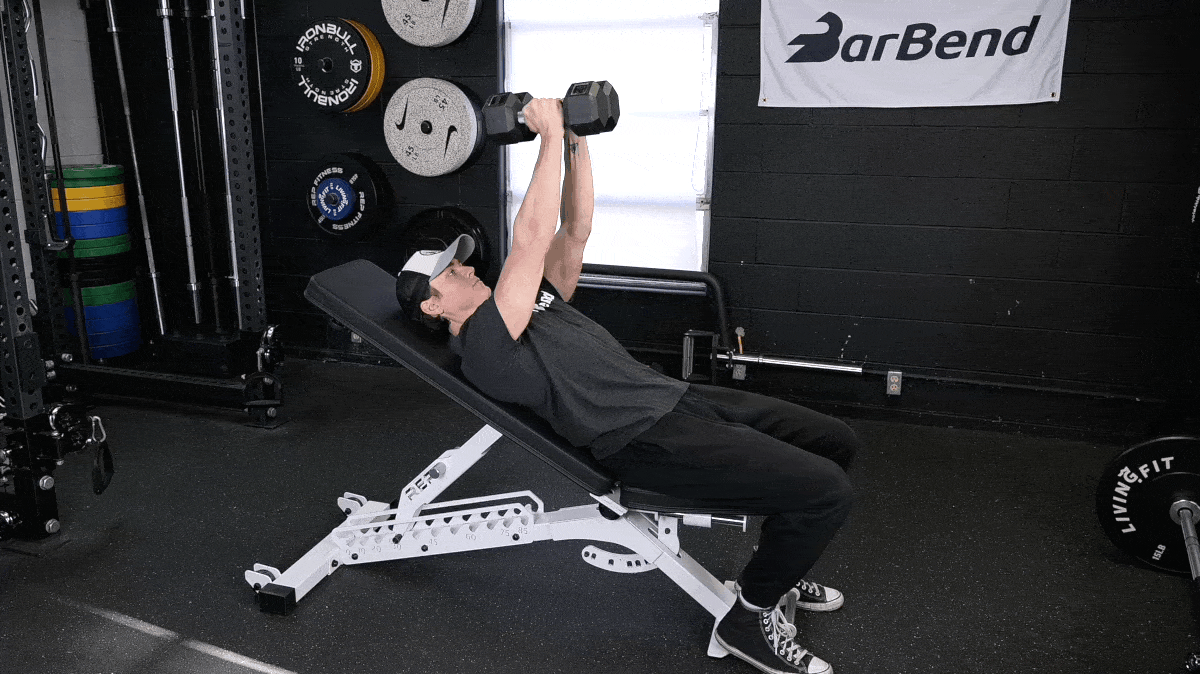
[Read More: Build Strong and Full Pecs With the Best Lower Chest Exercises]
To build the best pair of pecs you can, you need to do more than slam presses on a flat bench (though that’s certainly a good starting point). Upper chest exercises to bias the top fibers in your chest can help a lot.
The incline hex press accomplishes several things at once. You can train your triceps and front delts simultaneously, you can contract your chest isometrically and dynamically, and you can also engage your upper chest throughout.
How To Do It
[*]Lie on a low-to-medium incline bench with a pair of dumbbells above your head.
[*]Tuck your inner arms against your torso and clasp the sides of the dumbbells together.
[*]Squeeze them tightly and lower your arms down until the bells touch your chest.
[*]Reverse the motion, ensuring the dumbbells don’t come apart at any point.
Modifications
Coach’s Tip: Actively push the dumbbells against one another the entire time.
8. Chest Flye
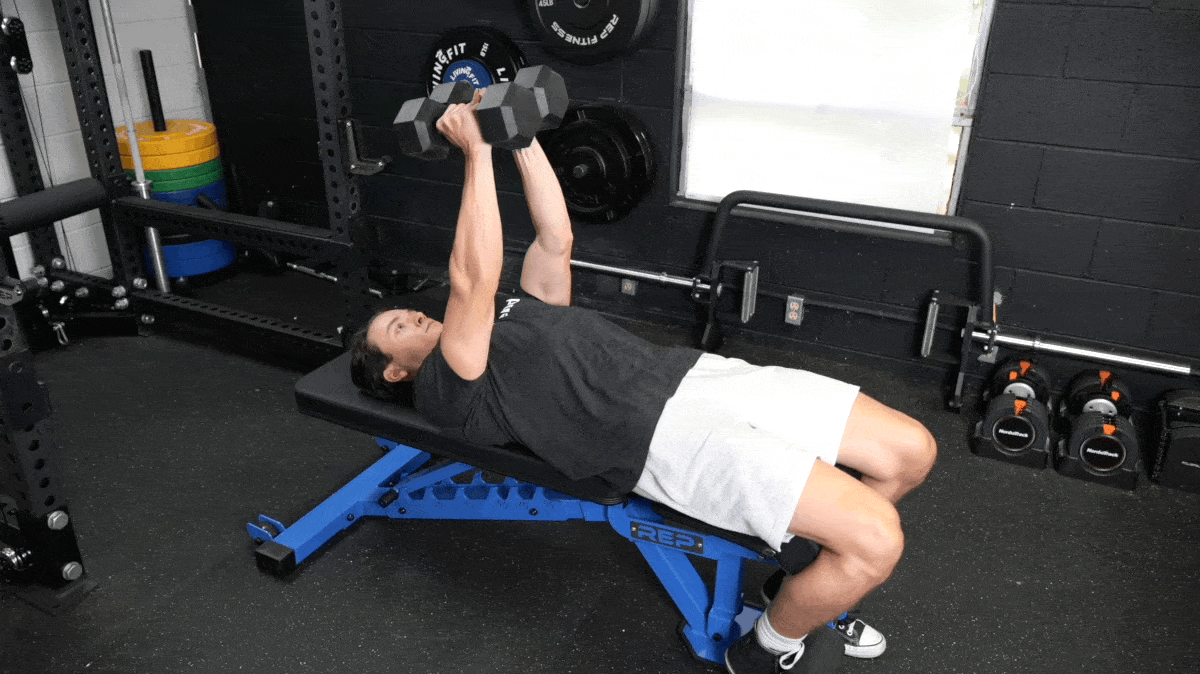
The chest flye — commonly called dumbbell flyes or cable flyes, depending on which implement you’re using — is a popular bodybuilding exercise to stretch the muscle fibers and pump up the muscle. Using dumbbells will also help improve your body’s ability to coordinate as you’re forced to stabilize each weight independently.
How To Do It
[*]Lie back on a bench (either flat, decline, or incline), with a dumbbell in each hand.
[*]With a slight bend in your elbows, lower your arms out to your sides slowly and with control.
[*]Reverse the motion, driving your upper arms against your torso as you return the weights to the starting position.
Modifications
Coach’s Tip: You can pause at the bottom of each rep for some productive loaded stretching.
9. Cable Press-Around
To make the most of your chest training, you should include exercises that take your pecs through their full range of motion. Neither flyes nor presses satisfy this requirement perfectly, but the cable press-around does. It also includes a rotational component and can stimulate your pecs in a whole new way if you can get the technique right.
How To Do It
[*]Stand facing at a 45-degree angle away from a cable handle set at around waist height.
[*]Grab the handle and allow it to pull tension across your chest.
[*]With a slightly bent elbow, sweep your arm around your torso.
[*]Squeeze your pecs hard. Pause for a beat at the end, and then reverse the motion.
Modifications
Coach’s Tip: Your arm should cross your midline to fully contract your pectorals.
10. Decline Push-Up
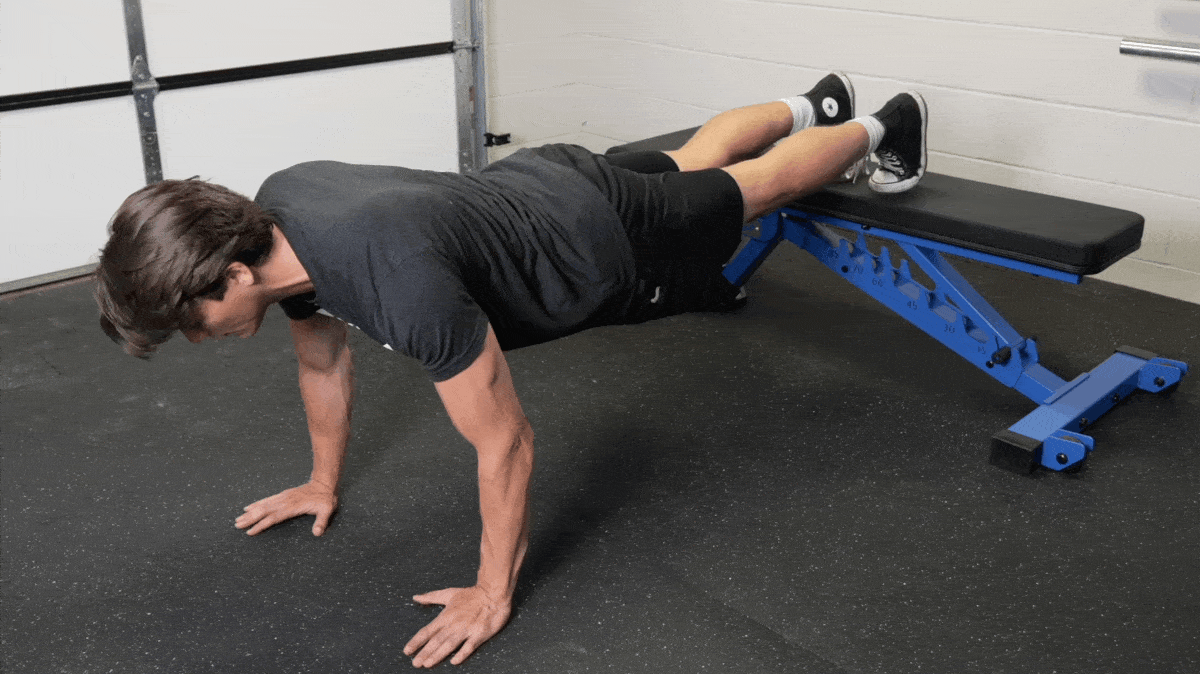
Push-ups aren’t just a beginner chest exercise. Modifying the movement by adjusting the angle of your body can emphasize different parts of your chest. By elevating your feet on a weight bench or plyo box, you’ll find that the decline push-up is far more difficult than the default move.
How To Do It
[*]Get into a push-up position with your feet elevated on a low plyo box or weight bench.
[*]From here, unlock your elbows and lower your body down toward the floor.
[*]When your elbows are behind your torso and you feel a deep stretch across your chest, push into the ground with your palms to return to the starting position.
Modifications
Coach’s Tip: The higher up your feet are, the harder the exercise becomes.
11. Close-Grip Bench Press
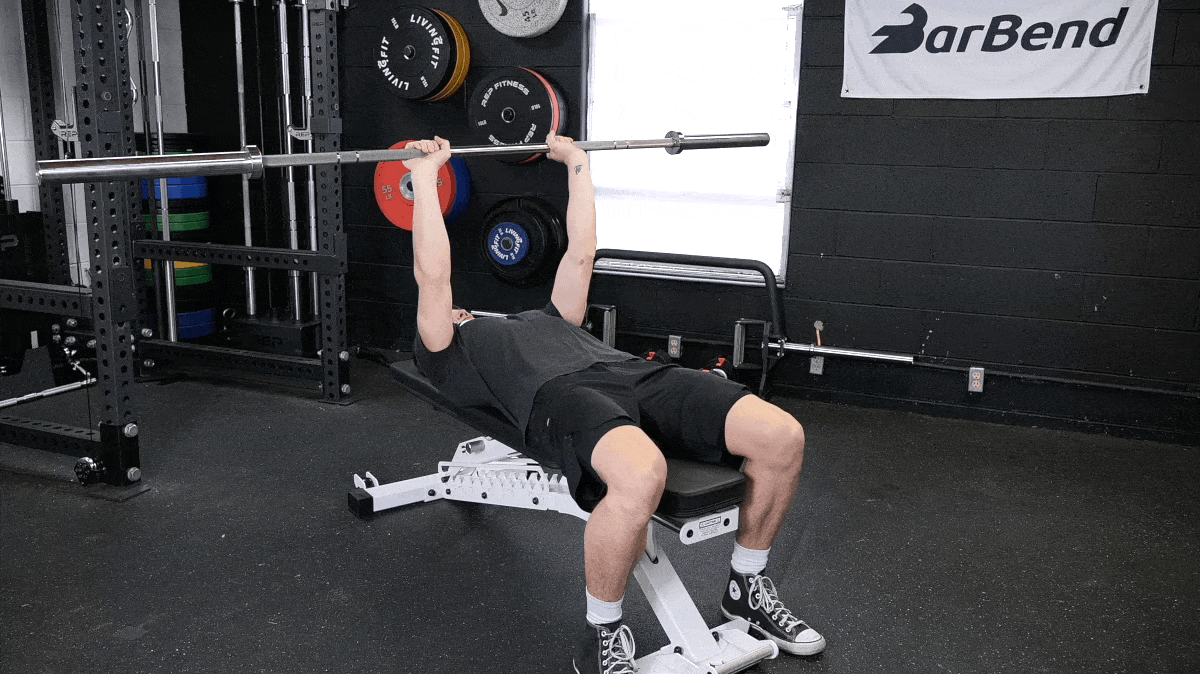
Performing the close-grip bench press will bias your upper pecs, triceps, and shoulders. The narrow grip is also a bit more comfortable for most folks, especially if performing the regular bench press irritates your shoulders.
How To Do It
[*]Set up in a bench press station with your eyes directly under the barbell and your feet planted on the floor.
[*]Grip the bar with a narrow, shoulder-width (or slightly closer) grip.
[*]Unrack it from the station by pulling it straight out until your arms are extended directly over your shoulders.
[*]Lower the bar down to your torso while keeping your upper arms tucked tightly to your sides.
[*]Reverse the motion, pressing up and back until the bar is over your shoulders once again.
Modifications
Coach’s Tip: The bar should touch your chest a bit below the nipple line.
12. Svend Press
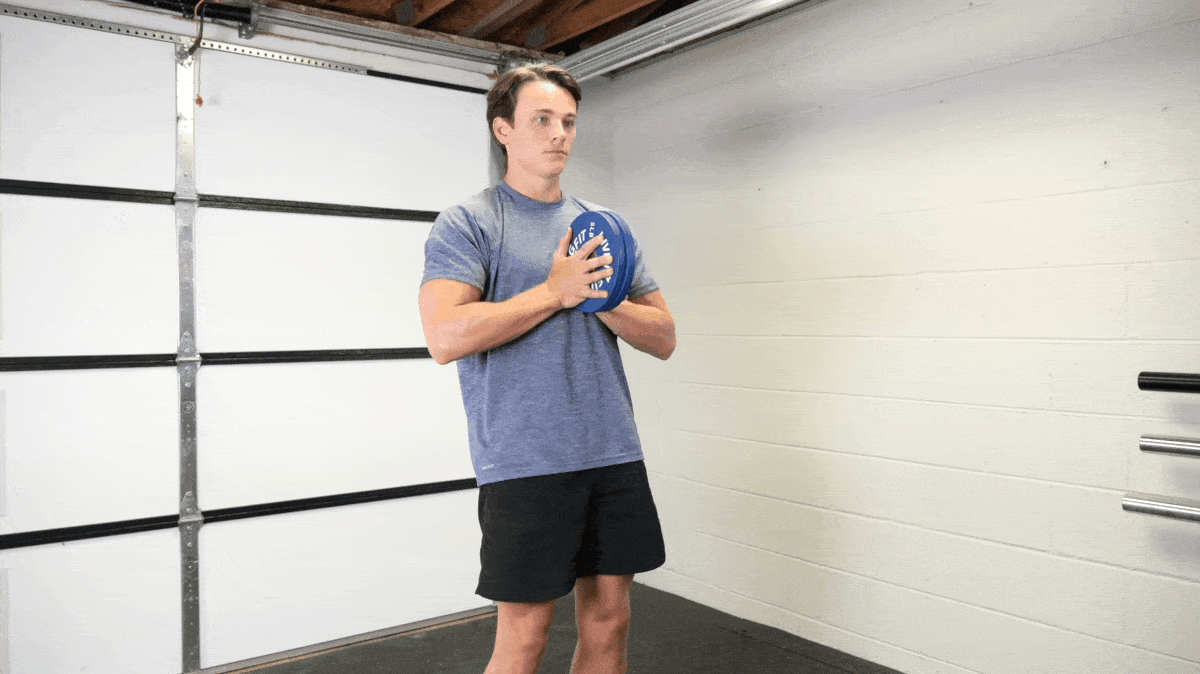
Of all the free-weight chest exercises, this one might look the silliest. But it’s certainly effective. To avoid dropping two plates on your toes, you need to squeeze the weights together continuously. That alone will get those pecs activated.
Then, you’ll extend your arms to squeeze the chest together even more. The Svend press is low-impact and thus easier to handle than doing even more heavy pressing. It also requires little equipment (making it the best chest exercise at home because you won’t need to wait for a bench to open up in a busy gym.)
How To Do It
[*]Start by taking two smaller weight plates (five or 10-pound plates) and pressing them together between your hands.
[*]Your arms should be extended outwards in front of you.
[*]While actively pinching the plate together and not letting them slip apart (constant tension), pull the plates towards your sternum as you keep your chest up and shoulder blades pulled together.
[*]Flex your chest and press the weights back outwards. Keep the plates pressed together and the inner chest muscles engaged.
Modifications
Coach’s Tip: Use the Svend press to prime your pecs between sets of other chest exercises.
13. Push-Up
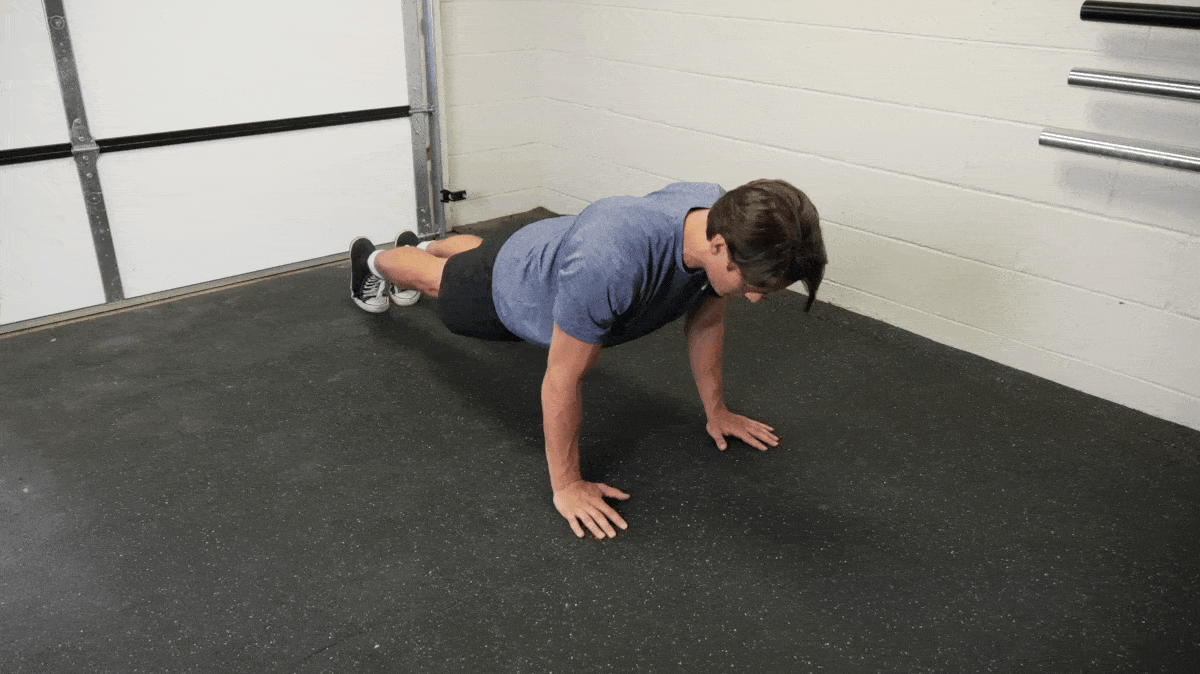
Alongside the dip, the push-up is the ruler of bodyweight chest exercises. Because you’re working out with just your body weight, your joints won’t be under as much stress as weighted movements. You can also really do a lot of pushups in a short amount of time, so you’ll accumulate more muscle-building stimulus overall.
How To Do It
[*]Get into a plank position, with your hands underneath your shoulders, back flat, and feet together.
[*]Screw your palms into the ground. You should feel your chest tighten.
[*]Hold this position, and then slowly lower yourself until your chest is about an inch from the floor.
[*]Now, drive back up through the palms of your hands.
Modifications
Coach’s Tip: Contract your abs hard. There should be no dip in your lower back.
14. Cable Crossover
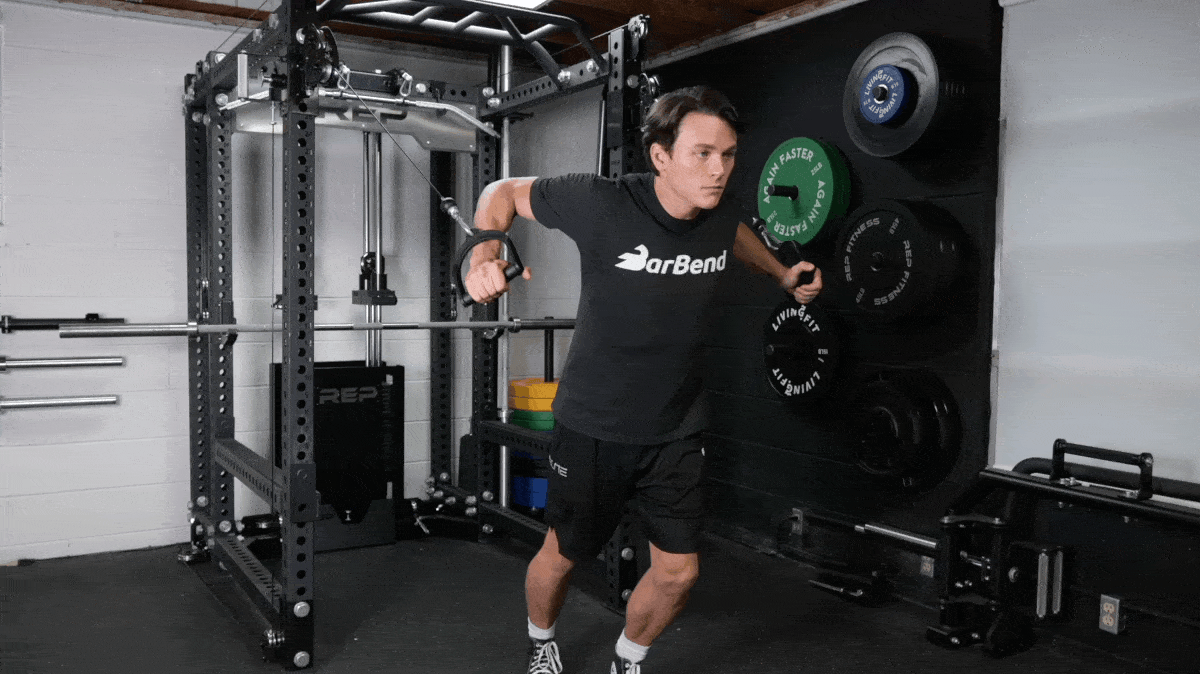
The cable crossover and cable flye are mostly the same exercise. You may choose to cross your hands over one another at the end of each repetition, but most of the value from this chest exercise comes from the deep, lengthened stretch it puts your pecs in. Crossovers (or cable flyes) make for one heck of a finisher during your chest workouts.
How To Do It
[*]Fix two D-handle attachments to the carabiners of two adjacent adjustable cable stations such that the handles are set around shoulder height.
[*]Grab each handle while facing away from the cable stack and take a step forward to pull the weight taut.
[*]With your elbows mostly straight, draw your arms around and forward toward your midline.
[*]If you choose to, you can cross your hands over one another to form an “X” shape with the cables.
Modifications
Coach’s Tip: As you bring your arms together in front of you, think about aggressively driving your upper arms into the sides of your chest.
15. Plyo Push-Up
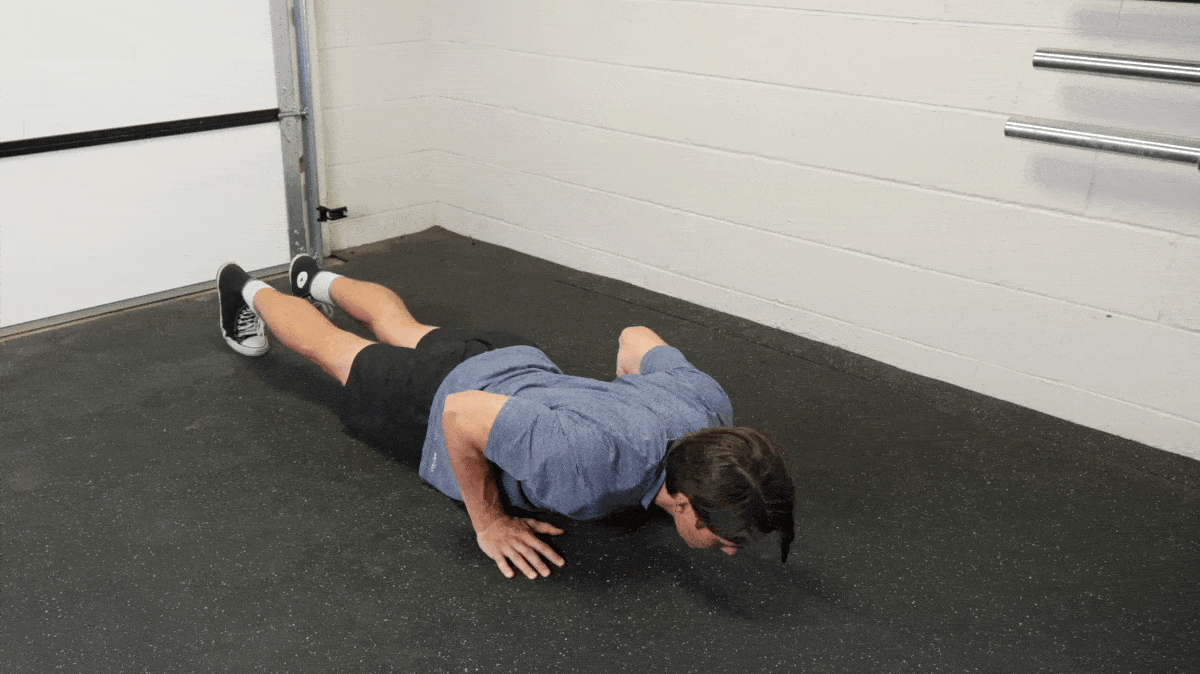
[Read More: 8 Push-Up Variations for Power, Strength, and Size]
When you get into the higher push-up rep ranges, you’re training muscular endurance and not just muscle-building. Enter the plyo push-up, one of the more difficult push-up variations to perform.
You’ll primarily be training power rather than run-of-the-mill endurance. Performing the plyo push-up will activate your fast-twitch muscle fibers, which have tremendous potential for growth. This isn’t just important for aesthetics. More powerful muscles can directly carry over to your bench-pressing prowess.
How To Do It
[*]Get into a push-up position with your hands underneath your shoulders.
[*]Lower yourself to the floor.
[*]Explosively push yourself up, with your hands leaving the ground.
[*]Slightly bend your elbows on the way down to better absorb the force.
[*]Rapidly descend into another push-up. Repeat.
Modifications
Coach’s Tip: You don’t need to push yourself off the floor as high as possible, you just need to explosively contract your pecs and arms.
16. Dumbbell Pullover
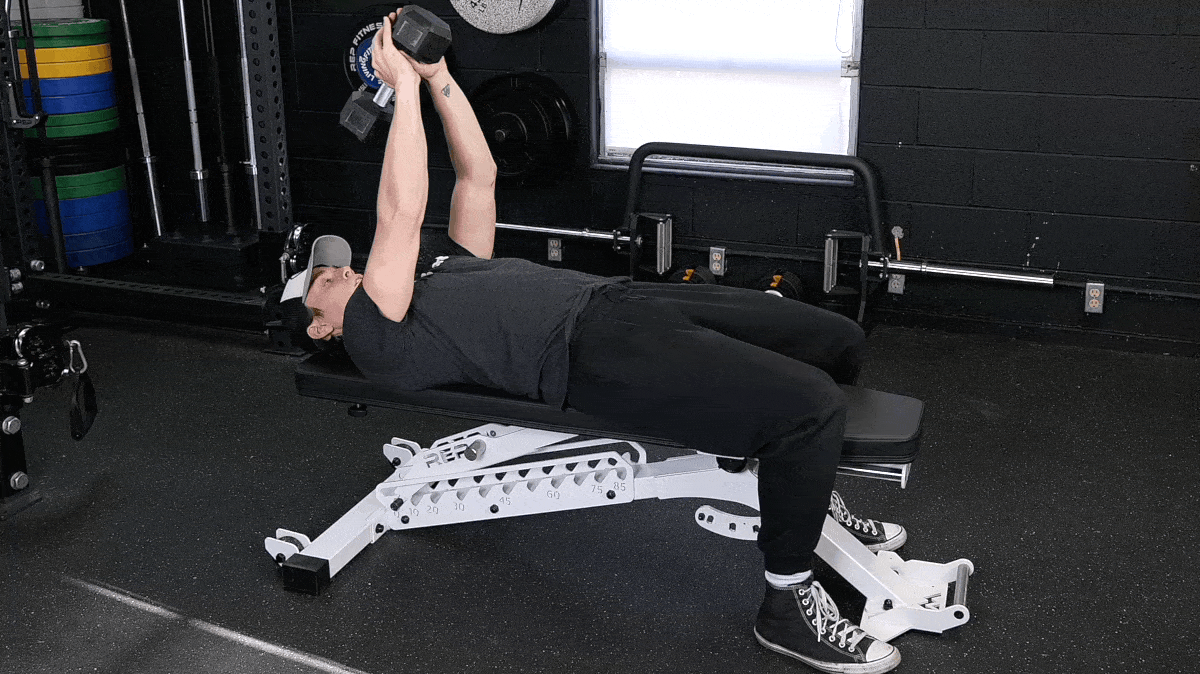
[Read More: The Best Dumbbell Chest Workouts for Beginners, Strength, and More]
The dumbbell pullover is one of the best dumbbell chest exercises you can do, simply because of the unique setup and execution. This is one of the only chest-building moves that targets your upper pecs while also stimulating your lats and triceps as well. Classical bodybuilders revered the pullover for its ability to shape a v-tapered torso — try it out for yourself and see why.
How To Do It
[*]Lie down on a weight bench, either normally or perpendicular to the bench with your pelvis just off the floor.
[*]Hold a dumbbell in your hands directly above your face.
[*]With your elbows mostly straight, guide the weight back behind your head until your arms are perpendicular to the floor.
[*]Reverse the motion, contracting your pecs and pulling the weight back into view above your face.
Modifications
Coach’s Tip: Place your palms up against the underside of the plate instead of clasping it by the handle.
17. Close-Grip Push-Up
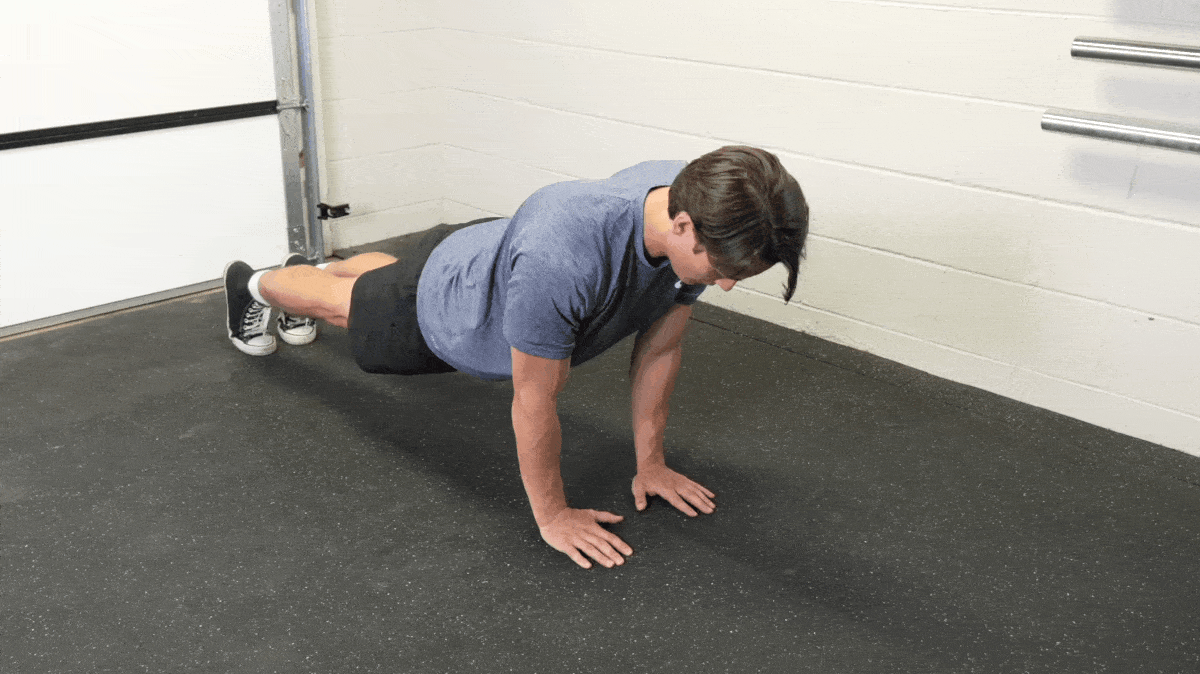
[Read More: Build a Titanic Torso with These Bodybuilding Chest & Back Workouts]
Because of the reduced base of support, the close-grip push-up is a bit more challenging than standard push-ups. But you’ll be training the pectorals from a different angle for better muscle development. Since your shoulders are more internally rotated and less externally rotated, you’ll take some of the pressure off your shoulder joints.
How To Do It
[*]Get into a plank position. Keep your hands close together, back flat, and feet wider than hip-width.
[*]Screw your palms into the ground. Try to feel your chest tighten.
[*]Slowly lower yourself until your chest is about an inch from the floor and your upper arms are touching your sides.
[*]Drive back up until lockout. Reset and repeat.
Modifications
Coach’s Tip: Wearing wrist wraps may alleviate some discomfort during this exercise.
4 Chest Workouts To Try
There’s no all-in-one “best” chest workout; it all depends on your goals and what you want out of your pec training. Want to build a pair of pecs you can balance a beer can on? We’ve got you covered. Need to bring up your bench press max ahead of your next powerlifting meet? You should probably get comfortable with the barbell. Try out
Chest Workout for Strength
A good strength-focused chest workout begins on the bench press. The barbell bench press allows you to lift tremendous amounts of weight for progressive overload, and is also the standard by which most people measure true chest strength.
Afterward, follow your benching up with a few smartly selected accessory movements, and you’re off to the races:
Chest Workout for Mass
You might be able to lift heavy, but if you’re not training for chest hypertrophy, it might not look that way. If you really want to target your chest for size, you’ll want to choose moderately heavy weights and focus on time under tension, and achieving an adequate range of motion. Your chest has a lot of dimensions, so you’ll want to emphasize each chest angle with your training.
Chest Workout for Beginners
If you’re a gym newbie, you’re in the unique position to benefit a lot from a low amount of stimulus. What this means in practical terms is that you won’t need the kind of high-volume, comprehensive training that a lifter with several years of training under their belt requires to progress.
[Read More: 6 Chest Exercises Without Weights That Build Size and Strength]
Hitting this workout once, maybe twice per week is more than enough to start building up your chest.
Bodyweight Chest Workout
Endless, regular push-ups aren’t the only way to work your chest without equipment. Yes, a lot of push-ups will be involved. But you’ll also vary the types of push-ups, speed, range of motion, and angle. Just make sure your form is spotless throughout. You can perform this workout two or three times a week, depending on your experience level and comfort with bodyweight movements.
Perform these exercises back-to-back as a circuit, with little to no rest in between. Repeat the circuit three times in total, resting up to four minutes between rounds.
Chest Muscles
Your chest (or rather, the anterior compartment of your torso) houses your pecs … duh. But there’s more going on under the skin than you think, and more muscles at play as well.
[Read More: The Anatomy of Your Chest Muscles, Explained (and How to Train Them)]
Here are the major players you’ll work during any well-rounded chest workout:
[*]Pectoralis Major: This two-headed muscle connects from your clavicle and sternum onto your upper arm bone and is primarily responsible for arm flexion and shoulder adduction.
[*]Pectoralis Minor: This smaller pec muscle connects from your ribcage to your shoulder blade and assists the pec major in performing its duties.
[*]Serratus Anterior: The serratus anterior isn’t directly attached to the chest, but it sits on the lateral sides of your ribcage and performs many of the same functions. Namely, protracting your shoulder and flexing your arm forward.
[/list]
Benefits of Training Your Chest
Chest training isn’t just for the vain-of-heart beach bro or a competitive powerlifter. A well-developed pair of pecs is a statement and are surprisingly functional in real-world scenarios — for athletes of all genders.
Functional Pressing Power
A big bench press is the tip of the iceberg when it comes to chest training. Sure, throwing up two or three wheels on the bench is impressive. But strong pectoral muscles also assist in real-world or sport-related scenarios, such as performing push-ups for time, shoving an object or opponent away from you, and much more.
Upper Body Aesthetics
Many athletes come into the game searching for muscles that aren’t just functionally strong — they also want said muscles to look like they’re strong. For a lot of athletes, the chest can be a tricky area to build muscle mass. But by deploying smart training strategies for chest hypertrophy and selecting from the exercises we’ve listed here, you’ll be well on your way to accomplishing your pectoral dreams.
FAQs
How many chest exercises should you do per workout?[/b] The amount of volume you should do for your chest varies, but as a general rule, you’ll want to include at least one pressing exercise and one flye or crossover exercise per workout. Then, build up over time with additional volume if you need it.
What exercise activates the pecs the most?[/b] To really feel your chest, you’ll want to try out a cable-based flye movement. Cable flyes put a lot of mechanical tension across your pecs while limiting triceps and shoulder activation.
What are the best exercises with dumbbells?[/b] The incline dumbbell bench press is one of the best all-around dumbbell exercises for your chest, because you can access a larger range of motion and adjust the incline of the bench. You can also try the dumbbell flye and hex press.
...
Click here to view the article.
The post The Best Chest Exercises for Building Muscle, Plus 4 Full Workouts appeared first on BarBend.
If you’re hitting the gym on International Chest Day, you need the best chest exercises for mass, strength, and everything in-between. These 17 expert-selected movements are all but guaranteed to get you jacked, increase your strength, and help you stave off injury. Let’s get started.
17 Best Chest Exercises
[*]Flat Bench Press
[*]Incline Bench Press
[*]Decline Bench Press
[*]Dip
[*]Dumbbell Bench Press
[*]Dumbbell Floor Press
[*]Incline Dumbbell Hex Press
[*]Chest Flye
[*]Cable Press-Around
[*]Decline Push-Up
[*]Close-Grip Bench Press
[*]Svend Press
[*]Push-Up
[*]Cable Crossover
[*]Plyo Push-Up
[*]Dumbbell Pullover
[*]Close-Grip Push-Up
Recent Updates: This article was initially written by Mike Dewar, CSCS. It was edited by Alex Polish, Senior Editor and a certified personal trainer. On Mar. 4, 2024, BarBend‘s exercise selections were adjusted by BarBend Senior Writer Jake Dickson in order to better reflect science-based guidance for movement recommendations. Dickson holds a B.S. degree in Exercise Science and is a NASM-certified personal trainer.
1. Flat Bench Press

The bench press should be a staple in your routine for more chest size and strength, since compared to most other chest exercises, you can load the bench press up with a relatively heavy amount of weight. Beyond that, benching is necessary for powerlifters, since it’s one of the three lifts judged in a powerlifting meet.
How To Do It
[*]Lay back down on a bench, arch your lower back slightly, and plant your feet on the floor.
[*]Pull your shoulder blades together to enhance stability and upper back strength.
[*]Grab the bar and squeeze the hand hard to flex the arm and grip muscles maximally.
[*]With the load unracked, think about pulling the barbell to the body to touch the sternum/base of the chest.
[*]Press the weight upwards, making sure to keep your back tight, and shoulder blades pulled together.
Modifications
- Make It Easier: If you have one, try doing the bench press with a Swiss barbell to make it more comfortable on your joints.
- Make It Harder: Suspend your feet in the air while you bench to get a core workout.
Coach’s Tip: A strong spinal arch will reduce your range of motion and improve your leverage.
2. Incline Bench Press

The incline press is somewhat of a hybrid of an overhead press and flat bench press, and so pressing a barbell (or a pair of kettlebells or dumbbells) from an incline recruits more of the muscle fibers in the upper chest and taxes the shoulders a bit more.
How To Do It
[*]Adjust a weight bench so it is at a 45-degree angle and set up similarly to that of the flat bench press.
[*]Unrack the loaded barbell and begin to pull the load downwards to line with the upper chest (a few inches below the clavicle).
[*]With the shoulder blades pulled together and elbows angled at about 45 degrees.
[*]Push the barbell upward.
Modifications
- Make It Easier: Try a narrow grip if you experience shoulder pain, or limit your range of motion by not touching the bar to your chest.
- Make It Harder: Try pausing at the bottom of each repetition.
Coach’s Tip: Adjust the seat such that the barbell is slightly behind your eye line before you unrack it.
3. Decline Bench Press

[Read More: 5 Bench Press Programs to Build a Bigger, Stronger Chest]
This pressing variation is typically less strenuous on your shoulders than the standard bench press because of the shifted shoulder angle. You’ll also be able to target your inner chest from a different angle, which is important when you’re looking to develop a well-rounded musculature.
How To Do It
[*]Start by securing your feet into a decline bench set up and secure your upper back and hips to the bench (similar to the flat bench press).
[*]Unrack the weight and pull the load downwards toward the sternum while keeping the shoulder blades pulled together.
[*]Press through the barbell to lock out your elbows. Be sure not to allow the elbows to flare excessively out.
Modifications
- Make It Easier: You can also do this exercise with dumbbells if you don’t have a decline bench station.
- Make It Harder: Try adding chains to your bar for some dynamic tension.
Coach’s Tip: The barbell should hit lower on your chest than during a flat bench press or incline bench press.
4. Dip

The dip is another bodyweight gem. It comes out toward the top of this list and is also one of the best arm exercises out there — the dip really is a powerhouse. You’ll also seriously recruit your triceps, which are essentially involved in all pressing movements, so working them in tandem with the chest will help strengthen the synergistic muscles in unison.
How To Do It
[*]Grab the dip bar firmly and get yourself in the top of the dip position, with your upper back tight and shoulder blades squeezed together.
[*]Angle your torso slightly forward and allow your elbows to bend as they slightly tuck inwards towards the sides of the torso.
[*]Lower yourself down until your elbows bend at about 90 degrees.
[*]When ready, press through the handles and bring your body upright into the top of the dip position.
Modifications
- Make It Easier: Use an assisted dip station with a knee pad or loop a resistance band around the dip bars to give you a bit of elastic assistance.
- Make It Harder: Work up to doing weighted dips with a dip belt attached during this upper back exercise.
Coach’s Tip: Keep your shoulders packed down and away from your ears the entire time.
5. Dumbbell Bench Press

The dumbbell bench press doesn’t allow you to go as heavy as its barbell counterpart, but there’s a lot to like about this move. For one, you’re controlling two dumbbells, which works your chest (and the smaller stabilizer muscles around your shoulder joint) differently than the bench press.
Like all chest exercises with dumbbells, this move has a secret weapon — if you have a weaker side, this move’s unilateral nature allows one side to catch up to the other.
How To Do It
[*]Sit up on a flat bench and then hinge forward to pick up each dumbbell.
[*]Place each weight on a knee and get set.
[*]Lean back and then drive the dumbbells back towards you (carefully) with your knees, simultaneously pressing the weights over your chest.
[*]Lower the weights, keeping your elbows tucked in at 45 degrees until your elbows break 90 degrees.
[*]Then, drive the dumbbells back up.
Modifications
- Make It Easier: Try a neutral grip to take some tension off your shoulders.
- Make It Harder: Practice a three to four-second tempo while lowering the weights down to your chest.
Coach’s Tip: Push the weights both upward and in toward your midline.
6. Cable Press

The cable press allows you to to train your pecs through their two primary anatomical functions; arm adduction and shoulder flexion. In simple terms, the tension of the cable pulls your arm both backward and out to the side, doubling down on the stimulus to your pecs.
How To Do It
[*]Set up an adjustable weight bench a few feet in front of a cable station with the seat elevated high.
[*]The cables should be fixed with D-handle attachments and set to around shoulder height when you sit on the bench.
[*]Stand behind the bench, grab each handle, and step around the bench to sit in it.
[*]Simulate a chest press position while holding the handles with your elbows bent and out to the sides.
[*]Perform a chest press, driving the handles forward and inward toward your midline.
Modifications
- Make It Easier: Set the bench between the two cable attachments rather than in front of them to reduce your range of motion and make this chest and shoulder exercise easier to set up.
- Make It Harder: Play with the angle of the bench seat, you may find that a slightly lower incline makes the movement more challenging on your pecs.
Coach’s Tip: The setup for the cable press is clunky, especially if you use heavy weights. You may want a spotter’s help getting into position.
7. Incline Dumbbell Hex Press

[Read More: Build Strong and Full Pecs With the Best Lower Chest Exercises]
To build the best pair of pecs you can, you need to do more than slam presses on a flat bench (though that’s certainly a good starting point). Upper chest exercises to bias the top fibers in your chest can help a lot.
The incline hex press accomplishes several things at once. You can train your triceps and front delts simultaneously, you can contract your chest isometrically and dynamically, and you can also engage your upper chest throughout.
How To Do It
[*]Lie on a low-to-medium incline bench with a pair of dumbbells above your head.
[*]Tuck your inner arms against your torso and clasp the sides of the dumbbells together.
[*]Squeeze them tightly and lower your arms down until the bells touch your chest.
[*]Reverse the motion, ensuring the dumbbells don’t come apart at any point.
Modifications
- Make It Easier: Try a low incline here to reduce the load on your shoulders.
- Make It Harder: This exercise is well-suited for drop sets, so grab multiple pairs of dumbbells.
Coach’s Tip: Actively push the dumbbells against one another the entire time.
8. Chest Flye

The chest flye — commonly called dumbbell flyes or cable flyes, depending on which implement you’re using — is a popular bodybuilding exercise to stretch the muscle fibers and pump up the muscle. Using dumbbells will also help improve your body’s ability to coordinate as you’re forced to stabilize each weight independently.
How To Do It
[*]Lie back on a bench (either flat, decline, or incline), with a dumbbell in each hand.
[*]With a slight bend in your elbows, lower your arms out to your sides slowly and with control.
[*]Reverse the motion, driving your upper arms against your torso as you return the weights to the starting position.
Modifications
- Make It Easier: Do this move on the floor to ensure your arms don’t sink too deep below your torso.
- Make It Harder: Try the chest flye on a low incline bench to really challenge your upper pecs.
Coach’s Tip: You can pause at the bottom of each rep for some productive loaded stretching.
9. Cable Press-Around
To make the most of your chest training, you should include exercises that take your pecs through their full range of motion. Neither flyes nor presses satisfy this requirement perfectly, but the cable press-around does. It also includes a rotational component and can stimulate your pecs in a whole new way if you can get the technique right.
How To Do It
[*]Stand facing at a 45-degree angle away from a cable handle set at around waist height.
[*]Grab the handle and allow it to pull tension across your chest.
[*]With a slightly bent elbow, sweep your arm around your torso.
[*]Squeeze your pecs hard. Pause for a beat at the end, and then reverse the motion.
Modifications
- Make It Easier: You can perform this move while seated instead of standing.
- Make It Harder: Try doing a drop set for each of your arms.
Coach’s Tip: Your arm should cross your midline to fully contract your pectorals.
10. Decline Push-Up

Push-ups aren’t just a beginner chest exercise. Modifying the movement by adjusting the angle of your body can emphasize different parts of your chest. By elevating your feet on a weight bench or plyo box, you’ll find that the decline push-up is far more difficult than the default move.
How To Do It
[*]Get into a push-up position with your feet elevated on a low plyo box or weight bench.
[*]From here, unlock your elbows and lower your body down toward the floor.
[*]When your elbows are behind your torso and you feel a deep stretch across your chest, push into the ground with your palms to return to the starting position.
Modifications
- Make It Easier: Try lowering the elevation of your feet by supporting them on a bumper plate.
- Make It Harder: Add a weight plate to your upper back or hold a resistance band in your hands to make this move harder.
Coach’s Tip: The higher up your feet are, the harder the exercise becomes.
11. Close-Grip Bench Press

Performing the close-grip bench press will bias your upper pecs, triceps, and shoulders. The narrow grip is also a bit more comfortable for most folks, especially if performing the regular bench press irritates your shoulders.
How To Do It
[*]Set up in a bench press station with your eyes directly under the barbell and your feet planted on the floor.
[*]Grip the bar with a narrow, shoulder-width (or slightly closer) grip.
[*]Unrack it from the station by pulling it straight out until your arms are extended directly over your shoulders.
[*]Lower the bar down to your torso while keeping your upper arms tucked tightly to your sides.
[*]Reverse the motion, pressing up and back until the bar is over your shoulders once again.
Modifications
- Make It Easier: Try the close-grip floor press to limit your range of motion if needed.
- Make It Harder: Pick your feet up and place them on the end of the bench to ratchet up the stability requirement.
Coach’s Tip: The bar should touch your chest a bit below the nipple line.
12. Svend Press

Of all the free-weight chest exercises, this one might look the silliest. But it’s certainly effective. To avoid dropping two plates on your toes, you need to squeeze the weights together continuously. That alone will get those pecs activated.
Then, you’ll extend your arms to squeeze the chest together even more. The Svend press is low-impact and thus easier to handle than doing even more heavy pressing. It also requires little equipment (making it the best chest exercise at home because you won’t need to wait for a bench to open up in a busy gym.)
How To Do It
[*]Start by taking two smaller weight plates (five or 10-pound plates) and pressing them together between your hands.
[*]Your arms should be extended outwards in front of you.
[*]While actively pinching the plate together and not letting them slip apart (constant tension), pull the plates towards your sternum as you keep your chest up and shoulder blades pulled together.
[*]Flex your chest and press the weights back outwards. Keep the plates pressed together and the inner chest muscles engaged.
Modifications
- Make It Easier: Start with a yoga block instead of a weight plate.
- Make It Harder: Press two change plates together rather than using one alone.
Coach’s Tip: Use the Svend press to prime your pecs between sets of other chest exercises.
13. Push-Up

Alongside the dip, the push-up is the ruler of bodyweight chest exercises. Because you’re working out with just your body weight, your joints won’t be under as much stress as weighted movements. You can also really do a lot of pushups in a short amount of time, so you’ll accumulate more muscle-building stimulus overall.
How To Do It
[*]Get into a plank position, with your hands underneath your shoulders, back flat, and feet together.
[*]Screw your palms into the ground. You should feel your chest tighten.
[*]Hold this position, and then slowly lower yourself until your chest is about an inch from the floor.
[*]Now, drive back up through the palms of your hands.
Modifications
- Make It Easier: Perform push-ups with your body inclined by bracing against a low bench or box, or do kneeling push-ups instead.
- Make It Harder: Try doing push-ups with a weight plate on your upper back.
Coach’s Tip: Contract your abs hard. There should be no dip in your lower back.
14. Cable Crossover

The cable crossover and cable flye are mostly the same exercise. You may choose to cross your hands over one another at the end of each repetition, but most of the value from this chest exercise comes from the deep, lengthened stretch it puts your pecs in. Crossovers (or cable flyes) make for one heck of a finisher during your chest workouts.
How To Do It
[*]Fix two D-handle attachments to the carabiners of two adjacent adjustable cable stations such that the handles are set around shoulder height.
[*]Grab each handle while facing away from the cable stack and take a step forward to pull the weight taut.
[*]With your elbows mostly straight, draw your arms around and forward toward your midline.
[*]If you choose to, you can cross your hands over one another to form an “X” shape with the cables.
Modifications
- Make It Easier: Lowering the cables to around the nipple or even hip height may make this move more comfortable for your shoulders.
- Make It Harder: Try doing crossovers one arm at a time, crossing your working arm past your midline and toward your opposite shoulder.
Coach’s Tip: As you bring your arms together in front of you, think about aggressively driving your upper arms into the sides of your chest.
15. Plyo Push-Up

[Read More: 8 Push-Up Variations for Power, Strength, and Size]
When you get into the higher push-up rep ranges, you’re training muscular endurance and not just muscle-building. Enter the plyo push-up, one of the more difficult push-up variations to perform.
You’ll primarily be training power rather than run-of-the-mill endurance. Performing the plyo push-up will activate your fast-twitch muscle fibers, which have tremendous potential for growth. This isn’t just important for aesthetics. More powerful muscles can directly carry over to your bench-pressing prowess.
How To Do It
[*]Get into a push-up position with your hands underneath your shoulders.
[*]Lower yourself to the floor.
[*]Explosively push yourself up, with your hands leaving the ground.
[*]Slightly bend your elbows on the way down to better absorb the force.
[*]Rapidly descend into another push-up. Repeat.
Modifications
- Make It Easier: You can do these from a kneeling position to make them easier.
- Make It Harder: Try landing both a frontal and behind-the-back clap while you’re in the air.
Coach’s Tip: You don’t need to push yourself off the floor as high as possible, you just need to explosively contract your pecs and arms.
16. Dumbbell Pullover

[Read More: The Best Dumbbell Chest Workouts for Beginners, Strength, and More]
The dumbbell pullover is one of the best dumbbell chest exercises you can do, simply because of the unique setup and execution. This is one of the only chest-building moves that targets your upper pecs while also stimulating your lats and triceps as well. Classical bodybuilders revered the pullover for its ability to shape a v-tapered torso — try it out for yourself and see why.
How To Do It
[*]Lie down on a weight bench, either normally or perpendicular to the bench with your pelvis just off the floor.
[*]Hold a dumbbell in your hands directly above your face.
[*]With your elbows mostly straight, guide the weight back behind your head until your arms are perpendicular to the floor.
[*]Reverse the motion, contracting your pecs and pulling the weight back into view above your face.
Modifications
- Make It Easier: Laying on a decline bench will slightly reduce the range of motion required in your shoulders.
- Make It Harder: Try this move with a straight-bar cable attachment rather than a dumbbell.
Coach’s Tip: Place your palms up against the underside of the plate instead of clasping it by the handle.
17. Close-Grip Push-Up

[Read More: Build a Titanic Torso with These Bodybuilding Chest & Back Workouts]
Because of the reduced base of support, the close-grip push-up is a bit more challenging than standard push-ups. But you’ll be training the pectorals from a different angle for better muscle development. Since your shoulders are more internally rotated and less externally rotated, you’ll take some of the pressure off your shoulder joints.
How To Do It
[*]Get into a plank position. Keep your hands close together, back flat, and feet wider than hip-width.
[*]Screw your palms into the ground. Try to feel your chest tighten.
[*]Slowly lower yourself until your chest is about an inch from the floor and your upper arms are touching your sides.
[*]Drive back up until lockout. Reset and repeat.
Modifications
- Make It Easier: Do these on your knees instead of with straight legs.
- Make It Harder: Try adding a weight plate to your upper back.
Coach’s Tip: Wearing wrist wraps may alleviate some discomfort during this exercise.
4 Chest Workouts To Try
There’s no all-in-one “best” chest workout; it all depends on your goals and what you want out of your pec training. Want to build a pair of pecs you can balance a beer can on? We’ve got you covered. Need to bring up your bench press max ahead of your next powerlifting meet? You should probably get comfortable with the barbell. Try out
Chest Workout for Strength
A good strength-focused chest workout begins on the bench press. The barbell bench press allows you to lift tremendous amounts of weight for progressive overload, and is also the standard by which most people measure true chest strength.
Afterward, follow your benching up with a few smartly selected accessory movements, and you’re off to the races:
Chest Workout for Mass
You might be able to lift heavy, but if you’re not training for chest hypertrophy, it might not look that way. If you really want to target your chest for size, you’ll want to choose moderately heavy weights and focus on time under tension, and achieving an adequate range of motion. Your chest has a lot of dimensions, so you’ll want to emphasize each chest angle with your training.
Chest Workout for Beginners
If you’re a gym newbie, you’re in the unique position to benefit a lot from a low amount of stimulus. What this means in practical terms is that you won’t need the kind of high-volume, comprehensive training that a lifter with several years of training under their belt requires to progress.
[Read More: 6 Chest Exercises Without Weights That Build Size and Strength]
Hitting this workout once, maybe twice per week is more than enough to start building up your chest.
Bodyweight Chest Workout
Endless, regular push-ups aren’t the only way to work your chest without equipment. Yes, a lot of push-ups will be involved. But you’ll also vary the types of push-ups, speed, range of motion, and angle. Just make sure your form is spotless throughout. You can perform this workout two or three times a week, depending on your experience level and comfort with bodyweight movements.
Perform these exercises back-to-back as a circuit, with little to no rest in between. Repeat the circuit three times in total, resting up to four minutes between rounds.
Chest Muscles
Your chest (or rather, the anterior compartment of your torso) houses your pecs … duh. But there’s more going on under the skin than you think, and more muscles at play as well.
[Read More: The Anatomy of Your Chest Muscles, Explained (and How to Train Them)]
Here are the major players you’ll work during any well-rounded chest workout:
[*]Pectoralis Major: This two-headed muscle connects from your clavicle and sternum onto your upper arm bone and is primarily responsible for arm flexion and shoulder adduction.
[*]Pectoralis Minor: This smaller pec muscle connects from your ribcage to your shoulder blade and assists the pec major in performing its duties.
[*]Serratus Anterior: The serratus anterior isn’t directly attached to the chest, but it sits on the lateral sides of your ribcage and performs many of the same functions. Namely, protracting your shoulder and flexing your arm forward.
[/list]
Benefits of Training Your Chest
Chest training isn’t just for the vain-of-heart beach bro or a competitive powerlifter. A well-developed pair of pecs is a statement and are surprisingly functional in real-world scenarios — for athletes of all genders.
Functional Pressing Power
A big bench press is the tip of the iceberg when it comes to chest training. Sure, throwing up two or three wheels on the bench is impressive. But strong pectoral muscles also assist in real-world or sport-related scenarios, such as performing push-ups for time, shoving an object or opponent away from you, and much more.
Upper Body Aesthetics
Many athletes come into the game searching for muscles that aren’t just functionally strong — they also want said muscles to look like they’re strong. For a lot of athletes, the chest can be a tricky area to build muscle mass. But by deploying smart training strategies for chest hypertrophy and selecting from the exercises we’ve listed here, you’ll be well on your way to accomplishing your pectoral dreams.
FAQs
How many chest exercises should you do per workout?[/b] The amount of volume you should do for your chest varies, but as a general rule, you’ll want to include at least one pressing exercise and one flye or crossover exercise per workout. Then, build up over time with additional volume if you need it.
What exercise activates the pecs the most?[/b] To really feel your chest, you’ll want to try out a cable-based flye movement. Cable flyes put a lot of mechanical tension across your pecs while limiting triceps and shoulder activation.
What are the best exercises with dumbbells?[/b] The incline dumbbell bench press is one of the best all-around dumbbell exercises for your chest, because you can access a larger range of motion and adjust the incline of the bench. You can also try the dumbbell flye and hex press.
...
Click here to view the article.




